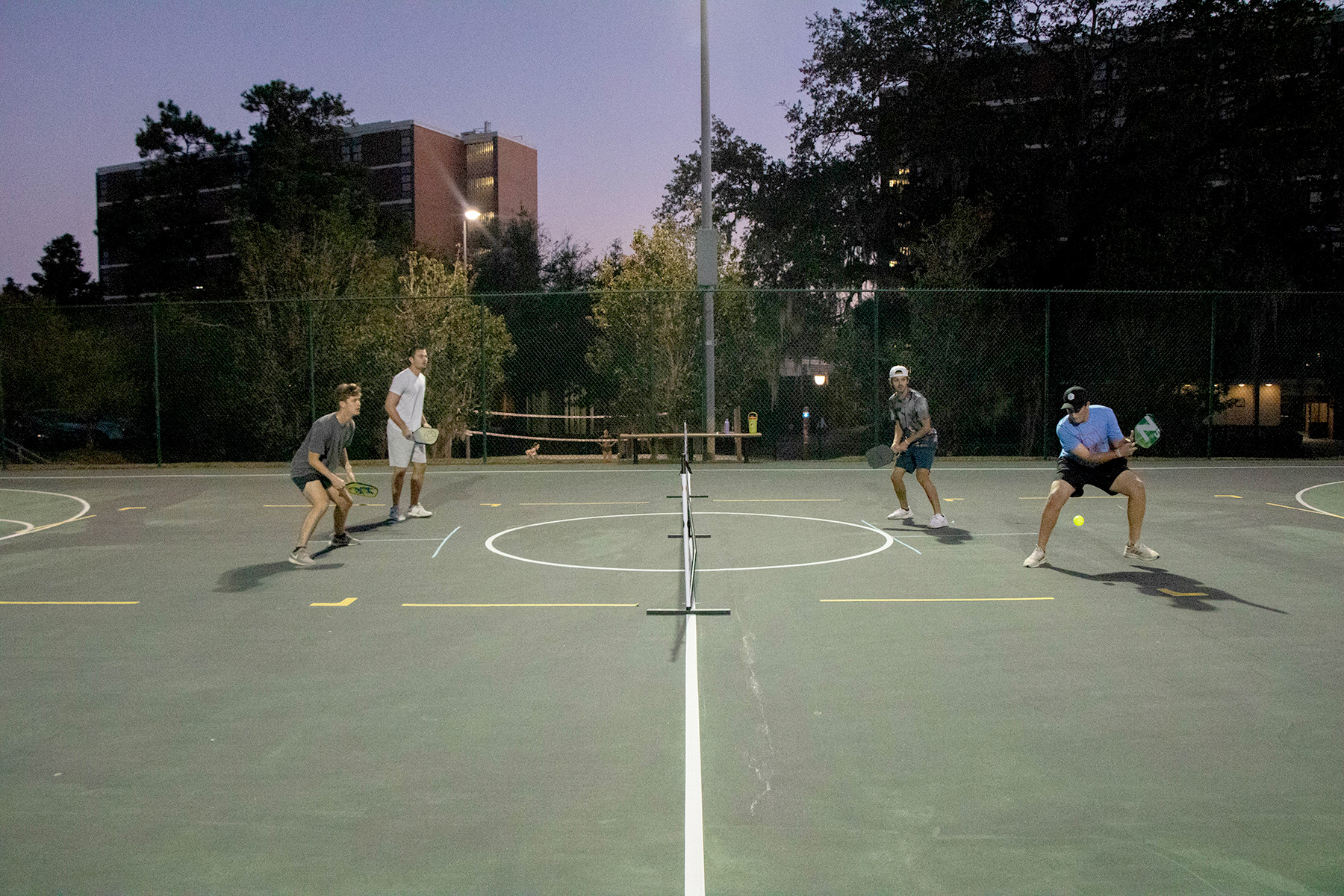Playing Rules
Updated August 13, 2024
General Rules
Florida State University does not provide accident insurance coverage for injuries received by Intramural Sports participants. Each participant should make sure that they have coverage either through family policies or the student insurance plan.
Florida State University PROHIBITS possession or consumption of alcoholic beverages on University property. Smoking and the use of smokeless tobacco is also prohibited at Campus Recreation facilities. This includes the Rec SportsPlex, Main Campus Fields, Westside Courts, and Tully Gym. Violators will be asked to leave the area. Failure to do so can result in forfeiture of the contest, suspension of individuals and/or teams, and appropriate action by the Office of Student Conduct & Community Standards and/or the FSU Police.
Sport Rules
I. GENERAL ELIGIBILITY
1. Participation is limited to currently-enrolled, fee-paying FSU students, faculty members, and full-time staff. FAMU & TCC students and members of the community are not eligible.
2. In order to participate in an intramural contest, each player must present their current, valid FSUCard. Check-in takes place at designated sign-in locations at the facility, not at the fields or courtside.
3. Additional information regarding player eligibility, team rosters, and participant check-in is available in the Seven Principles of Intramural Sports, available online at the FSU Intramural Sports website and in the Intramural Sports Office at the Main Campus Fields (1001 W. St. Augustine Street). Requests for exceptions to any policy must be directed to the IM administrative staff during regular weekday business hours in the Intramural Sports Office. No exceptions are granted at the fields or courts.
II. TEAM COMPOSITION
1. Players can compete on one single-gender and co-ed team only. A team’s roster may include up to 4 players.
2. Each team will play with 2 players on the court.
III. TIMING & SCORING
1. Game time is forfeit time.
2. Games are to 11 points, win by 2. A match is won by winning 2 of 3 games.
IV. INCLEMENT WEATHER
1. Intramural Sports reserves the right to postpone or reschedule a contest if circumstances warrant such action. Contests postponed due to inclement weather or other reasons may or may not be rescheduled at the discretion of the Intramural Sports staff.
2. In the case of inclement weather, the Intramural Sports staff will make a decision regarding the playing of games after 4:00 pm. Players should call the IM Sports RainLine at 850-645-RAIN or visit the Intramural Sports web site for rainout information. If inclement weather occurs after the closing of the Intramural Sports Office, decisions regarding the continuation of the games will be made at the facility by the IM supervisors.
3. A playoff game stopped because of inclement weather will be resumed at the point that the game is suspended. Regular season games stopped because of inclement weather are generally not completed; no win or loss is recorded in this case, however sporting behavior ratings will apply.
V. EQUIPMENT
1. All players must wear closed-toe shoes. Tennis shoes and soft-soled shoes are legal. No metal cleats or shoes with detachable cleats are allowed. Boots and sandals are also prohibited. Any player caught wearing metal spikes will be ejected from the game.
2. Select jewelry is allowed to be worn during intramural competition.
Below is a list of jewelry that is not allowed:
• Hard plastic / metal jewelry including rings, watches, bracelets, etc.
• Jewelry with loose hanging loops / hoops
• Non-stud piercings
If a finger could fit through the space of a loose piece of jewelry, then it must be taken off. Sport specific Jewelry Policies may still apply. There is absolutely no jewelry allowed beneath the elbow in the following sports:
• Flag football (7v7 & 4v4)
• Basketball (3v3 & 5v5)
• Volleyball (Indoor & Sand)
If necklaces are worn, they must be tucked in and always remain tucked in. Individuals wearing religious or medical alert jewelry will be allowed to participate while wearing jewelry containing necessary information. In such cases, the jewelry should be taped to the skin with the medical information visible. The Intramural Sports Staff and Supervisors have the final say on approved jewelry for each sport.
3. Racquets will be provided by the Intramural Sports staff at the game site. If you have your own personal racquet, feel free to use it.
4. Pickleball is played on a standard pickleball sized court.
VI. RULES OF PLAY
THE SERVE
1.1. Players use a coin toss to determine who will serve first. The winner of the coin toss will have the option to choose side or to serve or receive.
1.2. The serve must be made underhand.
1.3. Paddle contact with the ball must be below the server’s waist (navel level).
1.4. The serve is initiated with at least one foot behind the baseline; neither foot may contact the baseline or court until after the ball is struck.
1.5. The serve is made diagonally crosscourt and must land within the confines of the opposite diagonal court.
1.6. Only one serve attempt is allowed, except in the event of a let (the ball touches the net on the serve and lands on the proper service court; let serves are replayed).
SERVICE SEQUENCE
2.1. Both players on the serving team have the opportunity to serve and score points until they commit a fault *(except for the first service sequence of each new game).
2.2. The first serve of each side-out is made from the right-hand court.
2.3. If a point is scored, the server switches sides and the server initiates the next serve from the left-hand court.
2.4. As subsequent points are scored, the server continues switching back and forth until a fault is committed and the first server loses the serve.
2.5. When the first server loses the serve, the partner then serves from their correct side of the court (except for the first service sequence of the game*).
2.6. The second server continues serving until their team commits a fault and loses the serve to the opposing team.
2.7. Once the service goes to the opposition (at side out), the first serve is from the right-hand court and both players on that team have the opportunity to serve and score points until their team commits two faults.
SCORING
3.1. Points can only be scored by the serving team.
3.2. Games are played to 11 points, win by 2.
3.3. When the serving team’s score is even (0, 2, 4, 6, 8, 10) the player who was the first server in the game for that team will be in the right-side court when serving or receiving; when odd (1, 3, 5, 7, 9) that player will be in the left-side court when serving or receiving.
DOUBLE BOUNCE RULE
4.1. When the ball is served, the receiving team must let it bounce before returning, and then the serving team must let it bounce before returning, thus two bounces.
4.2. After the ball has bounced once in each team’s court, both teams may either volley the ball (hit the ball before it bounces) or play it off a bounce (ground stroke).
4.3. The double bounce rule eliminates the serve and volley advantage, extending rallies.
NON-VOLLEY ZONE
5.1. The non-volley zone is the court area within 7 feet on both sides of the net.
5.2. Volleying is prohibited within the non-volley zone. This rule prevents players from executing smashes from a position within the zone.
5.3. It is a fault if, when volleying a ball, the player steps on the non-volley zone, including the line and/or when the player’s momentum causes them or anything they are wearing or carrying to touch the non-volley zone including the associated lines.
5.4. It is a fault if, after volleying, a player is carried by momentum into or touches the non-volley zone, even if the volleyed ball is declared dead before this happens.
5.5. A player may legally be in the non-volley zone any time other than when volleying a ball
5.6. The non-volley zone is commonly referred to as “the kitchen.”
LINE CALLS
6.1. A ball contacting any line, except the non-volley zone line on a serve, is considered “in.”
6.2. A serve contacting the non-volley zone line is ruled as a fault.
FAULTS
7.1. A fault is any action that stops play because of a rule violation.
7.2. A fault by the receiving team results in a point for the serving team.
7.3. A fault by the serving team results in the loss of serve or side out.
A fault occurs when:
7.4.1. A serve does not land within the confines of the receiving court
7.4.2. The ball is hit into the net on the serve or any return
7.4.3. The ball is volleyed before a bounce has occurred on each side
7.4.4. The ball is hit out of bounds
7.4.5. A ball is volleyed from the non-volley zone
7.4.6. A ball bounces twice before being struck by the receiver
7.4.7. A player, player’s clothing, or any part of a player’s paddle touches the net or the net post when the ball is in play
7.4.8. There is a violation of a service rule
7.4.9. A ball in play strikes a player or anything the player is wearing or carrying
7.4.10. A ball in play strikes any permanent object before bouncing on the court
VII. SPORTING BEHAVIOR
1. The mission of Intramural Sports is to provide a recreational environment for the University community which is safe and enjoyable. While the game atmosphere is often competitive, ensuring participant safety, providing a fun, social atmosphere, and promoting good sporting behavior among participants, spectators, and team followers are our primary concerns. The game atmosphere should remain good-natured at all times. Participants shall maintain good sporting behavior throughout their participation in all facets of the intramural program.
2. The Sporting Behavior Rating System is intended to be an objective scale by which teams’ attitude and behavior can be assessed throughout the intramural sports league and playoff seasons. Behavior before, during, and after an intramural sports contest is included in the rating. The team captain is responsible for educating and informing all players and spectators affiliated with their team about the system.
3. A team is responsible for the actions of the individual team members and spectators related to it. Additionally, FSU Intramural Sports does not recognize the use of coaches. Only the team captain shall speak to the officials regarding administrative matters (protests, ejections, disqualifications, etc). Furthermore, the team captain’s efforts in assisting officials/staff to calm difficult situations and to restrain troubled teammates are key to controlling team conduct.
4. Good sporting behavior is vital to the conduct of every Intramural contest. In order to encourage proper conduct during games, officials, administrative personnel, and supervisors shall make decisions on whether to warn, penalize or eject players or teams for poor sporting behavior. These decisions are final. The Intramural Sports administrative staff will rule on further penalties as a result of a sporting behavior conduct penalty.
5. Each participant should choose their team members carefully, as all team members will suffer the consequences of any disciplinary action taken by the Intramural Sports staff against that team for violation of the intramural rules and sporting behavior guidelines. Protests or appeals of sporting behavior ratings will not be recognized. The Intramural Sports administrative staff reserves the right to review any rating given to a team.
6. Additional information regarding team and participant sporting behavior including the rating method, factors, and scale is available in the Sporting Behavior Principle of the Seven Principles of Intramural Sports, available online at the FSU Campus Recreation web site.






